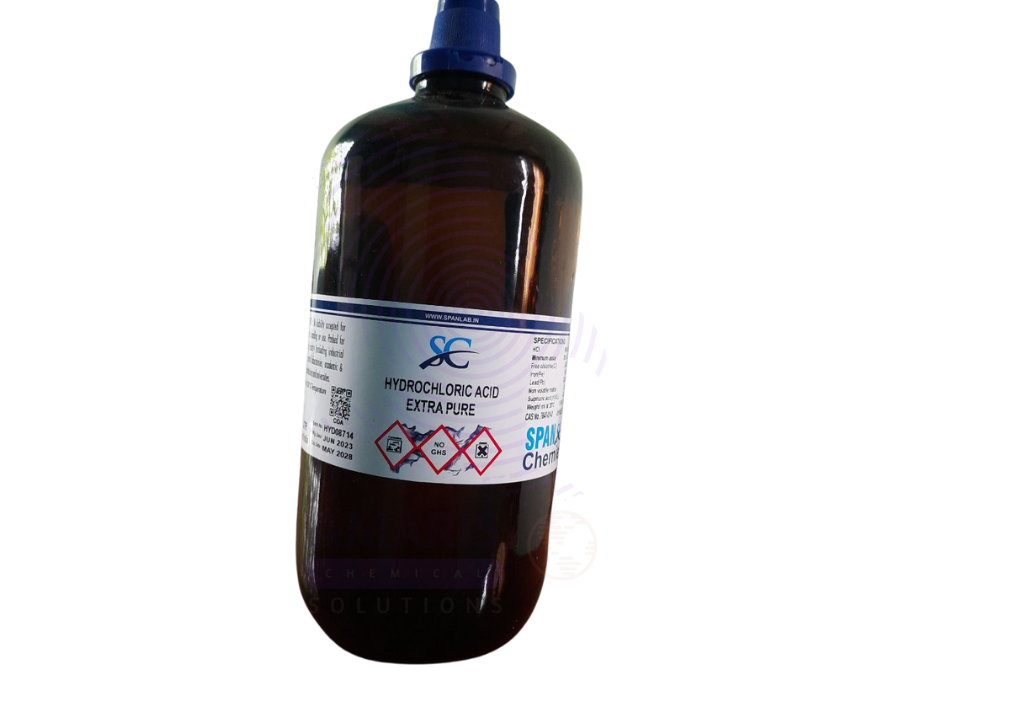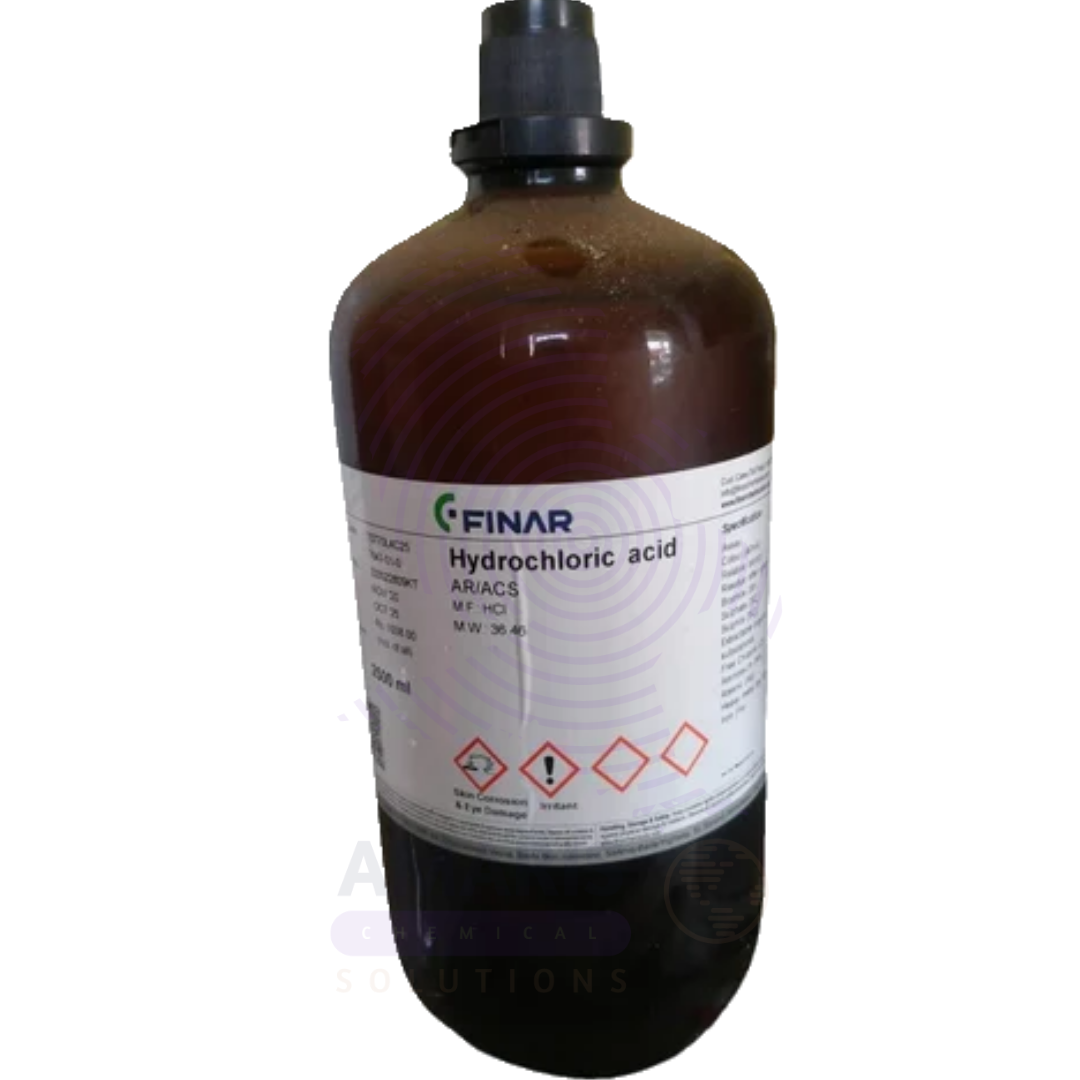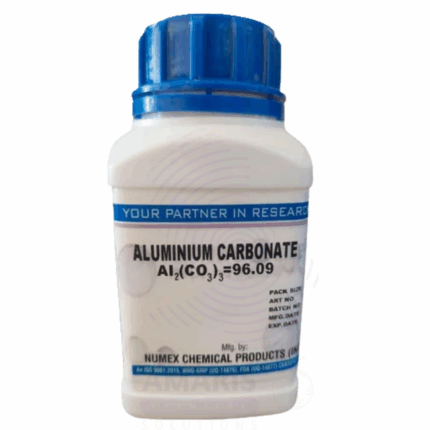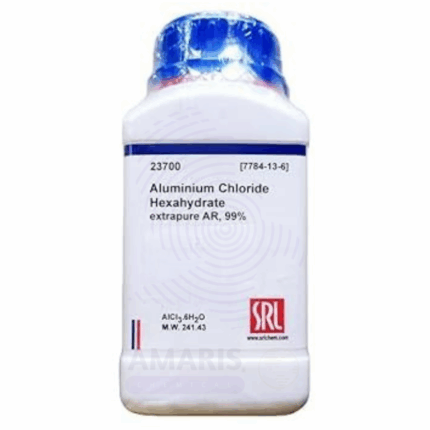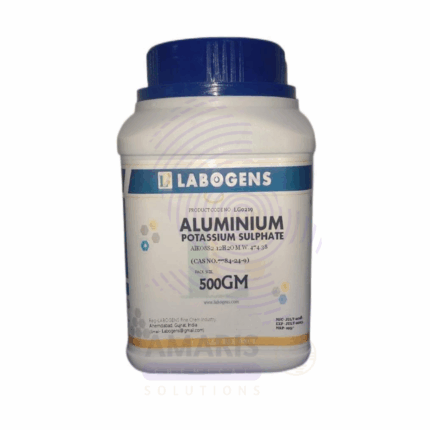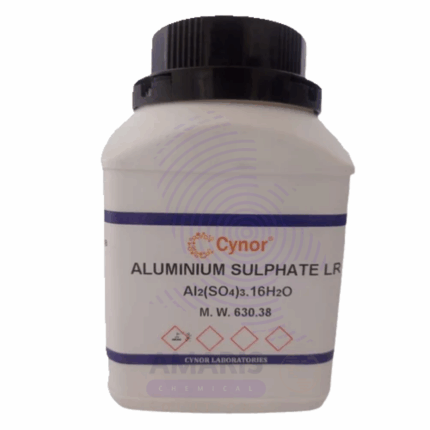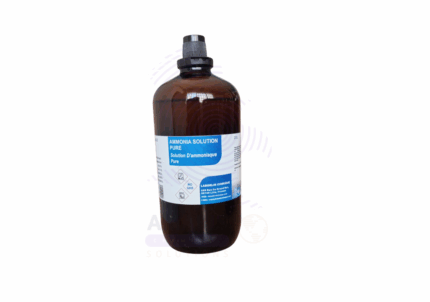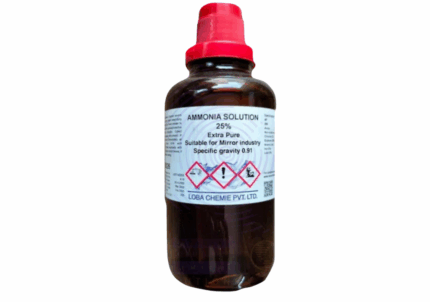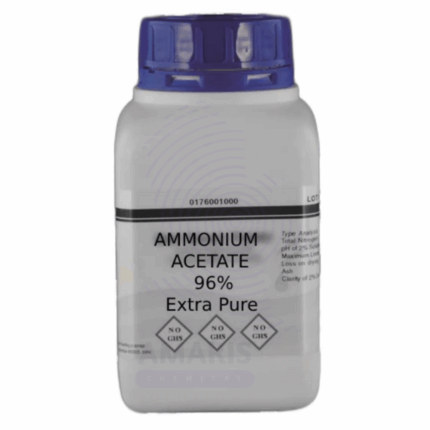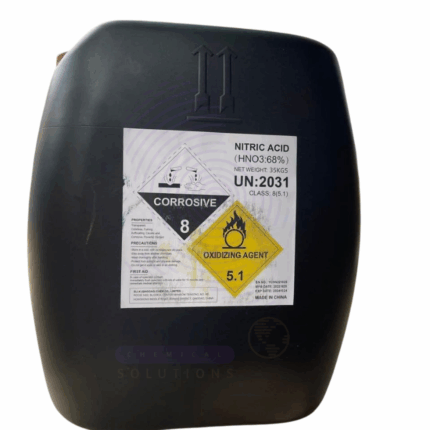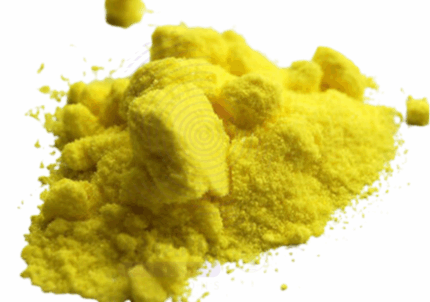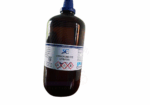
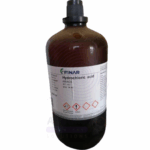
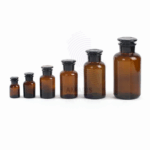
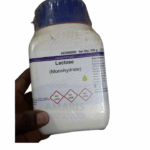
Hydrochloric Acid Extra Pure
$ 30.45 Original price was: $ 30.45.$ 30.23Current price is: $ 30.23.
Hydrochloric Acid Extra Pure is a highly concentrated and refined form of HCl, known for its exceptional purity and reliability in laboratory and analytical applications. This strong, corrosive mineral acid is commonly used for pH regulation, sample digestion, metal cleaning, and inorganic compound synthesis. Its extra pure grade ensures minimal impurities, making it suitable for high-precision chemical analysis, reagent preparation, and critical industrial processes. Due to its reactive and volatile nature, it must be handled with care under well-ventilated conditions and stored in corrosion-resistant containers.
Hydrochloric Acid Extra Pure
Primary Uses
- pH adjustment and acid-base titrations:
Commonly used to neutralize alkaline solutions or in quantitative titrations involving bases such as sodium hydroxide. - Preparation of water-soluble metal salts:
Reacts with metal oxides, hydroxides, and carbonates to produce chloride salts (e.g., zinc chloride, calcium chloride). - Digestion of samples for elemental analysis:
Employed in wet digestion procedures for preparing samples before ICP, AAS, or colorimetric analysis.
Secondary Uses
- Cleaning of glassware and removal of metal oxides:
Used to etch or clean glass surfaces, and to dissolve rust and scale from metal parts in apparatus. - Generation of hydrogen chloride gas (HCl):
Reacts with dehydrating agents like sulfuric acid to produce anhydrous HCl for gas-phase reactions. - Catalyst in organic reactions and hydrolysis processes:
Acts as a proton donor catalyst in reactions such as ester hydrolysis, amide cleavage, or chlorination steps.
| PACK SIZE |
2.5 Litres Glass bottle |
|---|
1. Basic Identification Attributes
- Product Name: Hydrochloric Acid
- Grade: Extra Pure (Laboratory Grade)
- Chemical Formula: HCl (in aqueous solution)
- CAS Number: 7647-01-0
- Molecular Weight: 36.46 g/mol
- Appearance: Colorless to slightly yellow liquid
- Odor: Pungent, irritating
2. Physical & Chemical Properties
- Concentration (Lab Grade): Typically 35–37% w/w HCl
- Density: ~1.18 g/cm³ (at 37%)
- Boiling Point: ~110 °C (concentration-dependent)
- Melting Point: -27 °C
- pH: <1 (strong acid)
- Solubility: Completely miscible in water and ethanol
- Vapor Pressure: High; fumes in moist air
3. Safety & Hazard Attributes
- GHS Classification:
⚠️ Corrosive, Irritant - Hazard Statements:
- H290: May be corrosive to metals
- H314: Causes severe skin burns and eye damage
- H335: May cause respiratory irritation
- PPE Requirements:
- Acid-resistant gloves (e.g., nitrile)
- Safety goggles or face shield
- Lab coat or chemical-resistant apron
- Use only in well-ventilated area or fume hood
- First Aid Measures:
- Skin Contact: Flush with plenty of water for at least 15 minutes
- Eye Contact: Rinse immediately with water; seek medical attention
- Inhalation: Move to fresh air; get medical help if symptoms persist
- Ingestion: Do not induce vomiting; seek immediate medical attention
4. Storage & Handling Attributes
- Storage Conditions:
- Store in a cool, well-ventilated acid cabinet
- Keep container tightly closed and away from incompatible substances
- Use only non-metallic containers or corrosion-resistant materials
- Incompatible Materials:
- Bases, oxidizing agents, ammonia, cyanides, and metals (liberates hydrogen gas)
- Handling Notes:
- Always add acid to water (never water to acid)
- Handle with care to avoid spills and fuming
5. Regulatory & Compliance Attributes
- DOT Classification: Corrosive liquid, acidic, inorganic, n.o.s.
- UN Number: UN1789
- Hazard Class: 8 (Corrosive)
- Packing Group: II or III (concentration-dependent)
- Labeling: Corrosive symbol required
6. Laboratory Applications
- Primary Uses:
- pH adjustment and acid-base titrations
- Preparation of metal chlorides and salts
- Cleaning and etching glassware
- Reactant in organic and inorganic synthesis
- Secondary Uses:
- Protein precipitation in biochemistry
- Regeneration of ion-exchange resins
- Removal of rust or scale from metal surfaces
SAFETY PRECAUTIONS
Personal Protective Equipment (PPE):
- Wear lab coat, chemical-resistant gloves (nitrile or neoprene), and splash-proof goggles.
- Use a face shield for additional protection.
- Always handle in a well-ventilated area or fume hood.
Handling:
- Avoid contact with skin, eyes, and clothing.
- Do not inhale vapors or mists.
- Never add water to acid; always add acid to water when diluting.
- Wash hands thoroughly after handling.
Storage:
- Store in a cool, dry, well-ventilated area away from incompatible substances.
- Keep container tightly closed and in corrosion-resistant, labeled containers.
- Avoid storing near bases, oxidizers, and metals.
FIRST AID MEASURES
Inhalation:
- Move person to fresh air immediately.
- Seek medical attention if breathing is difficult or symptoms persist.
Skin Contact:
- Rinse immediately with plenty of water for at least 15 minutes.
- Remove contaminated clothing and shoes.
- Seek medical attention for burns or persistent irritation.
Eye Contact:
- Rinse cautiously with water for several minutes.
- Remove contact lenses if present and easy to do.
- Continue rinsing and get medical attention immediately.
Ingestion:
- Rinse mouth with water. Do not induce vomiting.
- Give water to dilute only if the person is fully conscious.
- Seek immediate medical attention.
FIRE FIGHTING MEASURES
Flammability:
- Not flammable, but can emit toxic gases when heated.
Extinguishing Media:
- Use dry chemical, foam, or CO₂ for surrounding fire.
- Do not use water directly on the acid spill; may cause splattering.
Hazardous Combustion Products:
- Hydrogen chloride gas, chlorine gas.
Firefighter Protection:
- Use self-contained breathing apparatus (SCBA) and full protective gear.
- Approach fire from upwind to avoid corrosive vapors.


 Preservatives(food)
Preservatives(food) Flavor Enhancers
Flavor Enhancers Acidulants
Acidulants Sweeteners
Sweeteners Antioxidants
Antioxidants Colorants(food)
Colorants(food) Nutraceutical Ingredients (food)
Nutraceutical Ingredients (food) Nutrient Supplements
Nutrient Supplements Emulsifiers
Emulsifiers
 Collectors
Collectors Dust Suppressants
Dust Suppressants Explosives and Blasting Agents
Explosives and Blasting Agents Flocculants and Coagulants
Flocculants and Coagulants Frothers
Frothers Leaching Agents
Leaching Agents pH Modifiers
pH Modifiers Precious Metal Extraction Agents
Precious Metal Extraction Agents
 Antioxidants(plastic)
Antioxidants(plastic) Colorants (Pigments, Dyes)
Colorants (Pigments, Dyes) Fillers and Reinforcements
Fillers and Reinforcements Flame Retardants
Flame Retardants Monomers
Monomers Plasticizers
Plasticizers Polymerization Initiators
Polymerization Initiators Stabilizers (UV, Heat)
Stabilizers (UV, Heat)
 Antifoaming Agents
Antifoaming Agents Chelating Agents
Chelating Agents Coagulants and Flocculants
Coagulants and Flocculants Corrosion Inhibitors
Corrosion Inhibitors Disinfectants and Biocides
Disinfectants and Biocides Oxidizing Agents
Oxidizing Agents pH Adjusters
pH Adjusters Scale Inhibitors( water)
Scale Inhibitors( water)
 Antioxidants(cosmetic)
Antioxidants(cosmetic) Emollients
Emollients Fragrances and Essential Oils
Fragrances and Essential Oils Humectants
Humectants Preservatives
Preservatives Surfactants(cosmetic)
Surfactants(cosmetic) Thickeners
Thickeners UV Filters
UV Filters
 Fertilizers
Fertilizers Soil Conditioners
Soil Conditioners Plant Growth Regulators
Plant Growth Regulators Animal Feed Additives
Animal Feed Additives Biostimulants
Biostimulants Pesticides (Herbicides, Insecticides, Fungicides)
Pesticides (Herbicides, Insecticides, Fungicides)
 Active Pharmaceutical Ingredients (APIs)
Active Pharmaceutical Ingredients (APIs) Excipients
Excipients Solvents(pharmaceutical)
Solvents(pharmaceutical) Antibiotics
Antibiotics Antiseptics and Disinfectants
Antiseptics and Disinfectants Vaccine Adjuvants
Vaccine Adjuvants Nutraceutical Ingredients (pharmaceutical)
Nutraceutical Ingredients (pharmaceutical) Analgesics & Antipyretics
Analgesics & Antipyretics
 Analytical Reagents
Analytical Reagents Solvents(lab)
Solvents(lab) Chromatography Chemicals
Chromatography Chemicals Spectroscopy Reagents
Spectroscopy Reagents microbiology-and-cell-culture-reagents
microbiology-and-cell-culture-reagents Molecular Biology Reagents
Molecular Biology Reagents Biochemical Reagents
Biochemical Reagents Inorganic and Organic Standards
Inorganic and Organic Standards Laboratory Safety Chemicals
Laboratory Safety Chemicals Specialty Laboratory Chemicals(Special Laboratory Equipment)
Specialty Laboratory Chemicals(Special Laboratory Equipment)
 Demulsifiers
Demulsifiers Hydraulic Fracturing Fluids
Hydraulic Fracturing Fluids Scale Inhibitors(oil)
Scale Inhibitors(oil) Surfactants(oil)
Surfactants(oil) Drilling Fluids
Drilling Fluids
 Dyes and Pigments
Dyes and Pigments Bleaching Agents
Bleaching Agents Softening Agents
Softening Agents Finishing Agents
Finishing Agents Antistatic Agents
Antistatic Agents
 Admixtures
Admixtures Waterproofing Agents
Waterproofing Agents Sealants and Adhesives
Sealants and Adhesives Curing Compounds
Curing Compounds Concrete Repair Chemicals
Concrete Repair Chemicals Anti-Corrosion Coatings
Anti-Corrosion Coatings
 Surfactants(cleaning)
Surfactants(cleaning) Builders
Builders Enzymes
Enzymes Solvents (Cleaning)
Solvents (Cleaning) Fragrances
Fragrances
 Electronic Chemicals
Electronic Chemicals Catalysts
Catalysts Lubricants
Lubricants Photographic Chemicals
Photographic Chemicals Refrigerants
Refrigerants Automotive chemicals
Automotive chemicals Pyrotechnic Chemicals
Pyrotechnic Chemicals
 Biodegradable Surfactants
Biodegradable Surfactants Bio-based Solvents
Bio-based Solvents Renewable Polymers
Renewable Polymers Carbon Capture Chemicals
Carbon Capture Chemicals Wastewater Treatment Chemicals
Wastewater Treatment Chemicals
 Pigments
Pigments Solvents(paint)
Solvents(paint) Specialty Coatings
Specialty Coatings Binders/Resins
Binders/Resins Additives
Additives Driers
Driers Anti-Corrosion Agents
Anti-Corrosion Agents Functional Coatings
Functional Coatings Application-Specific Coatings
Application-Specific Coatings
 Fresh Herbs
Fresh Herbs Ground Spices
Ground Spices Whole Spices
Whole Spices Spice Blends
Spice Blends Dried Herbs
Dried Herbs
 Leavening Agents
Leavening Agents Dough Conditioners
Dough Conditioners Flour Treatments
Flour Treatments Fat Replacers
Fat Replacers Decoratives
Decoratives Preservatives(baking)
Preservatives(baking)
 Plasticizers & Softeners
Plasticizers & Softeners Reinforcing Agents
Reinforcing Agents Adhesion Promoters
Adhesion Promoters Vulcanizing Agents
Vulcanizing Agents Antidegradants
Antidegradants Blowing Agents
Blowing Agents Fillers & Extenders
Fillers & Extenders Accelerators & Retarders
Accelerators & Retarders